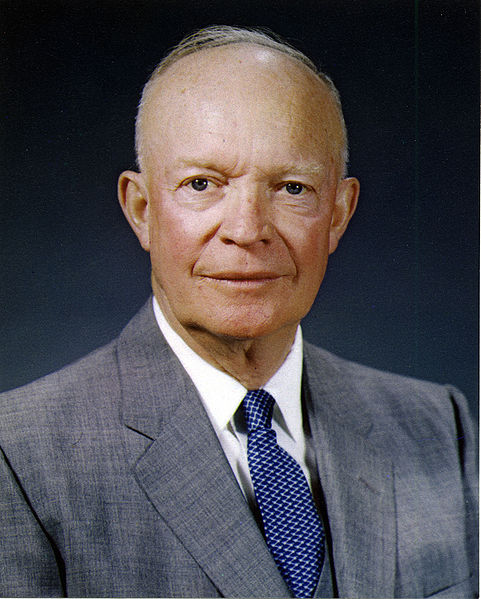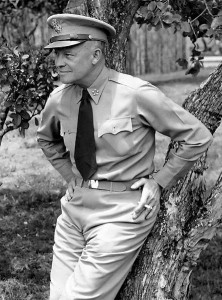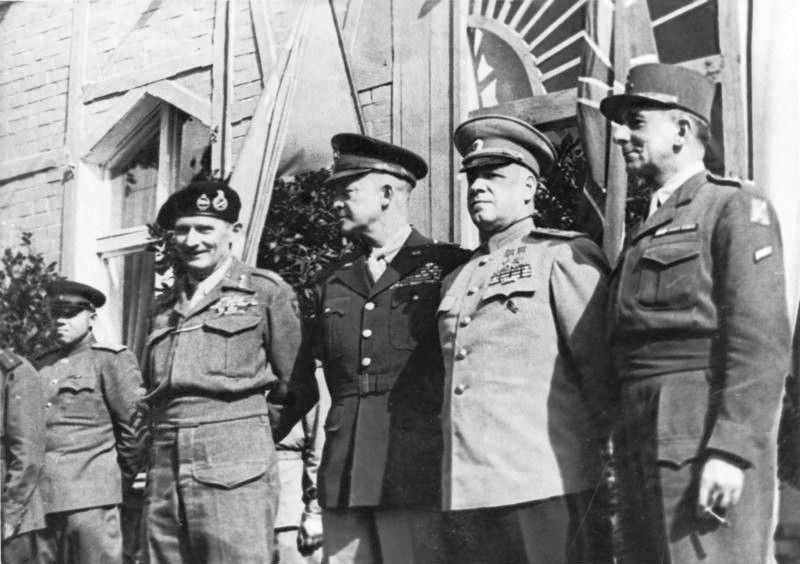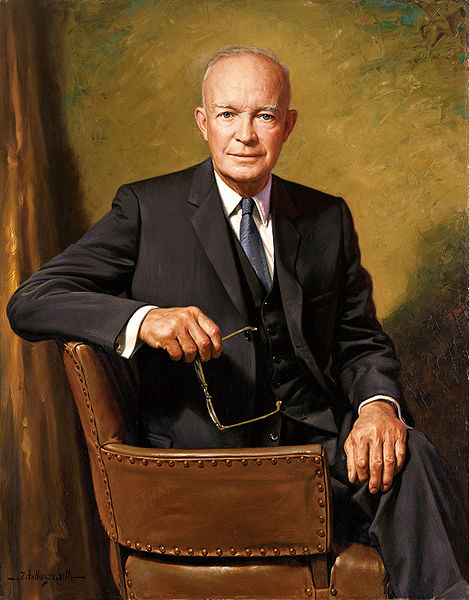| Dwight D. Eisenhower | |
|---|---|
 |
|
| 34th United States President « Previous Next » |
|
| In office | Jan. 20, 1953 – Jan. 20, 1961 |
| V. President | Richard Nixon |
| Political Party | Republican |
| Personal Info | |
| Born | Oct. 14, 1890 |
| Died | Mar. 28, 1969 (at age 78) |
| Religion | Presbyterianism |
| School | U.S Military Academy U.S. Army Command and General Staff College U.S. Army War College |
| Profession | U.S. Army Officer |
| Signature | |
| Wife | Mamie Eisenhower |
| Children | Doud Eisenhower John Eisenhower |
| U.S. Presidents 26-35 | |
| 26. Theodore Roosevelt (1901-1909) | |
| 27. William H. Taft (1909-1913) | |
| 28. Woodrow Wilson (1913-1921) | |
| 29. Warren G. Harding (1921-1923) | |
| 30. Calvin Coolidge (1923-1929) | |
| 31. Herbert Hoover (1929-1933) | |
| 32. Franklin D. Roosevelt (1933-1945) | |
| 33. Harry S. Truman (1945-1953) | |
| 34. Dwight D. Eisenhower (1953-1961) | |
| 35. John F. Kennedy (1961-1963) | |
| List of All the Presidents |
Dwight D. Eisenhower was born on October 14, 1890 to David and Ida Stover Eisenhower in Denison, Texas in the United States of America. The third of seven sons, he grew up in Abilene, Kansas where he excelled in sports in high school. In 1909, he graduated from Abilene High School.
Military Career
While he was working as night foreman at Belle Springs Creamery in 1909, he was encouraged by his friend, Swede Hazlett, to apply to Naval Academy in Annapolis, Maryland. Although he passed the entrance exam, he was not accepted because of age ineligibility. In 1911, Kansas Senator Joseph L. Bristow recommended Eisenhower to the US Military Academy at West Point in New York.
Although he did not excel academically at the Academy, Dwight D. Eisenhower still managed to graduate in 1915 in the upper half of his class. He was commissioned at Ft. Sam in Houston, Texas as a second lieutenant after graduation. He met his wife, Mamie Geneva Doud, in October 1915 when he was invited by a fellow soldier, Gee Gerow, to a casual lawn party where the Douds were also guests. They were married on July 1, 1916 at the Doud home in Denver.
He was assigned to different military posts in Georgia, Texas, Pennsylvania, Maryland, and New Jersey. He became a father to Doud Dwight in 1917 but the kid died of scarlet fever at age three. He became coach of the football team at St. Louis College while stationed at Ft. Sam Houston and trained new recruits for World War I duty overseas. On August 3, 1922, his second son John Sheldon Doud Eisenhower was born.
Dwight D. Eisenhower served under General Fox Conner as executive officer from 1922 to 1924 in the Panama Canal Zone during which Conner served as Eisenhower’s mentor. Under Conner, Eisenhower began learning about history, philosophy and military science. He was accepted at Command and General Staff School, an elite graduate school of the army, due to Conner’s assistance. He graduated top of his class in 1926.
He learned about cultures, geography and the peoples of Europe when he was assigned to write for the American Battle Monuments Commission under General John Pershing in 1927 in Paris and Washington. In 1933, he served as chief military aide to General Douglas McArthur, then US Army Chief of Staff. He was with General McArthur as assistant military advisor in the Philippines in 1935. In 1939, he was appointed to the 15th Infantry Regiment at Fort Lewis and was promoted to colonel in March 1941.
In June 1941, Dwight D. Eisenhower was appointed to Ft. Sam Houston as Chief of Staff to General Walter Krueger of the Third Army. He became known nationwide because of his bold leadership of the Third Army which routed decisively the Second Army in the Louisiana Maneuvers between August and September of that same year. He was promoted to Brigadier General a few months prior to the Pearl Harbor bombing.
 In March of 1942, he was promoted to Major General because of his impressive analytical, social, and organizational skills. He was sent to Europe on a special mission in May 1942 to build cooperation among the allied forces. He carried out Operation Torch as Commander in Chief of the Allied Forces by November. In 1943, he led the allied forces in its invasion of Italy and Sicily. Eisenhower was appointed Supreme Commander and led in the planning of Operation Overlord in December 1943.
In March of 1942, he was promoted to Major General because of his impressive analytical, social, and organizational skills. He was sent to Europe on a special mission in May 1942 to build cooperation among the allied forces. He carried out Operation Torch as Commander in Chief of the Allied Forces by November. In 1943, he led the allied forces in its invasion of Italy and Sicily. Eisenhower was appointed Supreme Commander and led in the planning of Operation Overlord in December 1943.
Dwight D. Eisenhower was promoted to General of the Army in December 1944. In May 1945, he was appointed Military Governor of the US Occupied Zone when Germany surrendered. He began to earn the respect, affection and admiration of the international community. In June 1945, Eisenhower was accorded a hero’s welcome when he returned to Abilene, Kansas.
In November 1945, he became the US Army’s Chief of Staff. He became President of Columbia University three years later. In December 1950, he took a leave of absence from Columbia University to become Supreme Allied Commander of NATO (North Atlantic Treaty Organization) where he helped build the organization along with other allied countries.
President Dwight D. Eisenhower
 On November 4, 1952, Dwight D. Eisenhower became the 34th President of the United States of America. He was elected a second time as President in 1956. He worked hard to curb communism but exerted a lot of effort to improve relations with the Soviet Union after the death of Joseph Stalin. He supported and signed the Civil Rights Acts of 1957 and 1960 although he was criticized by historians for not taking a leadership role on issues concerning racism.
On November 4, 1952, Dwight D. Eisenhower became the 34th President of the United States of America. He was elected a second time as President in 1956. He worked hard to curb communism but exerted a lot of effort to improve relations with the Soviet Union after the death of Joseph Stalin. He supported and signed the Civil Rights Acts of 1957 and 1960 although he was criticized by historians for not taking a leadership role on issues concerning racism.
Under Eisenhower, the United States of America enjoyed an expanding and strong economy. Unemployment was low, there was little inflation, and there was solid economic growth. Eisenhower increased minimum wage, expanded social security, and organized the Department of Health, Education and Welfare. He had sincere concern for the good of every American.
In 1956, Dwight D. Eisenhower supported and signed the bill authorizing the Interstate Highway System. His justification for the project was the Federal Aid Highway Act of 1956, which was important to the security of Americans during the Cold War. The highways were built on the premise that they were to be used to evacuate citizens and permit the military to move in should large cities be targeted in the event of a future war.
The Eisenhower Doctrine
On January 5, 1957, the Eisenhower Doctrine which referred to Eisenhower’s Speech where he stressed that a country can seek financial or military help from the United States of America if it was threatened by other countries through armed aggression. The speech was made in response to a possible generalized war which was a result of the Soviet Union’s effort to use the Suez Canal to enter Egypt. The Eisenhower Doctrine was used the following year in the Lebanon crisis where the US military intervened upon the request of Lebanon’s president, Camille Chamoun. The doctrine was also used to send financial help to the Kingdom of Jordan.
President Eisenhower’s Accomplishments
 It was during the term of Dwight D. Eisenhower, that the National Aeronautics and Space Administration were inaugurated. Space exploration also began during his term. Towards the end of his presidency in 1959, Alaska and Hawaii became states of the USA with the former being the 49th state and the latter, the 50th state.
It was during the term of Dwight D. Eisenhower, that the National Aeronautics and Space Administration were inaugurated. Space exploration also began during his term. Towards the end of his presidency in 1959, Alaska and Hawaii became states of the USA with the former being the 49th state and the latter, the 50th state.
The Central Intelligence Agency during Eisenhower’s term was able to depose the leaders of Guatemala, Iran and the Belgian Congo. In cooperation with the British government, he authorized the CIA to help in the overthrowing of Prime Minister Mohammad Mosaddegh and restoring the Shah of Iran to power.
Eisenhower became the 1st president to hire a White House Chief of Staff, an idea he got while he was still in the military. After Lyndon Johnson, every president also appointed his Chief of Staff. He was also the 1st US president to appear on color TV. His speech on May 21, 1958 during the dedication of the new studios of WRC-TV in Washington, DC was videotaped. It is believed that this videotape is the oldest surviving videotape.
Post-Presidency
He was best remembered for his presidential farewell speech on January 17, 1961 for his description of the “Military-Industrialization Complex”. He warned against dire consequences to self-government and personal freedoms if power is left unchecked. He retired at Gettysburg Farm in Pennsylvania where days were passed playing golf and painting.
Dwight D. Eisenhower wrote his memoirs, Mandate for Change in 1963, Waging Peace in 1965, and At Ease in 1967. He was often consulted by Presidents Kennedy and Johnson as an Elder Statesman. He often had guests at Gettysburg where he would treat them with home-cooked meals which he did himself. Winter seasons were mostly spent at their Palm Desert, California home.
He indulged in livestock raising and gardening. Afternoons were usually spent with Mamie on the porch, painting, reading, watching their favorite TV programs, and playing cards. In 1967, the farm was donated to the National Park Service. It’s been open to the public since 1980 and known as the Eisenhower National Historic Site.
The Final, Peaceful Days of Dwight D. Eisenhower
The last year of Dwight D. Eisenhower’s life was spent at Walter Army Reed Hospital in Washington, DC due to a weakening heart. He suffered a major heart attack on September 24, 1955 while he was still in office. He developed a left ventricular aneurysm which led to a mild stroke on November 25, 1957. After leaving the White House, he suffered numerous heart attacks which led to the deterioration of his health.
He died on March 28, 1969 due to congestive heart failure. He died peacefully. He was buried in simple chapel in Abilene on the Eisenhower Center grounds. He was also accorded a state funeral at Washington, DC. Full military honors were also given to him at Abilene. He was buried alongside his son, Doud Dwight, their firstborn. His wife Mamie, who died in 1979, was also buried there.